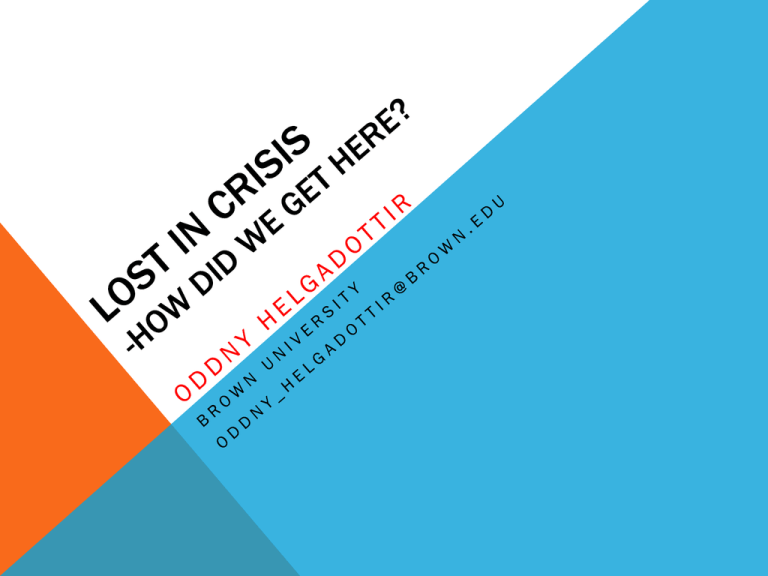2.2.lost_in_crises_oddny.ppt
advertisement

1. The mechanisms and narratives of crisis 2. The sequence of events 3. What is to be done? MECHANISMS AND NARRATIVES 1) the passing of time and cycles of memory 2) The end of history 3) Freedom = deregulation 4) Securitization and the “taming of risk” 5) The power of economic ideas 6) Discipline and punish 7) Inequality and its discontents 8) The revolving door THE SEQUENCE OF EVENTS OR HOW THE ECONOMY WENT OFF A CLIFF Blowing bubbles 1: the US and global stock market bubbles (1987-2010) 14000 DJIA & Nikkei 12000 10000 8000 6000 4000 2000 0 DJIA (USA) FTSE 100 (UK) Nikkei 225 (Japan) 45000 40000 35000 30000 25000 20000 FTSE 16000 15000 10000 5000 0 13 Blowing bubbles 2: the US and global housing bubbles (1997-2007) 14 Blowing bubbles 3: the global commodities bubble (1997-2009) 1200 140 1000 120 800 Gold Oil 600 400 200 0 100 80 60 Oil Gold 40 20 0 15 -2.0% 2000-I 2000-II 2000-III 2000-IV 2001-I 2001-II 2001-III 2001-IV 2002-I 2002-II 2002-III 2002-IV 2003-I 2003-II 2003-III 2003-IV 2004-I 2004-II 2004-III 2004-IV 2005-I 2005-II 2005-III 2005-IV 2006-I 2006-II 2006-III 2006-IV 2007-I 2007-II 2007-III 2007-IV 2008-I 2008-II 2008-III 2008-IV 2009-I 2009-II 2009-III 2009-IV 2010-I 2010-II 2010-III 2010-IV Falling asset prices hit the real economy 2 per. Mov. Avg. (GDP Growth (% annualized) SAAR) 10.0% 8.0% 6.0% 4.0% 2.0% 0.0% -4.0% -6.0% -8.0% U.S. Bureau of Economic Analysis (BEA) 16 U.S. Bureau of Labor Statistics (BLS) 1/1/2010 8/1/2009 3/1/2009 10/1/2008 5/1/2008 12/1/2007 7/1/2007 2/1/2007 9/1/2006 4/1/2006 11/1/2005 6/1/2005 1/1/2005 8/1/2004 3/1/2004 10/1/2003 5/1/2003 12/1/2002 7/1/2002 2/1/2002 9/1/2001 4/1/2001 11/1/2000 6/1/2000 1/1/2000 8/1/1999 3/1/1999 10/1/1998 5/1/1998 12/1/1997 7/1/1997 2/1/1997 9/1/1996 4/1/1996 11/1/1995 6/1/1995 1/1/1995 And unemployment rises (1995 – 2010) 25.00% U3 is the measure on unemployment you hear on the news (ORANGE). U6 (BLUE) is the broadest and ILO compliant measure. 20.00% 15.00% 10.00% 5.00% 0.00% 17 …which hits consumption… PCE Expenditures (% change QoQ) Personal Savings Rate (%) 8.00% 6.00% 4.00% 2.00% 0.00% 2010 2009 2008 2007 2006 2005 2004 2003 2002 2001 2000 1999 1998 1997 1996 -4.00% 1995 -2.00% -.7% -6.00% BEA 18 To stop this cycle, governments took on debt so the private sector could pay back debt Fiscal Balance of Advanced Economies as a % of GDP 1% 0% -1% -2% -3% -4% -5% -6% -7% -8% -9% -10% 1999 2000 2001 International Monetary Fund 2002 2003 2004 2005 2006 2007 2008 2009 19 The bailout in U.S. history BUT it is necessary to remember where all this debt came from Source: IMF Fiscal Monitor 2010 – total = 39.1% average debt increase The temperature rises in Europe …and bursts into flames …the fire brigade is not cheap But we are all very, very connected Who is in bed with the “PIGS”? What makes a “PIG”? (Central government debt as percent of GDP, 2010) Source: Standard & Poor’s from national sources And what makes a champion: The sources of Germany’s competitiveness What to make of this? Or this? Suppliers need consumers The burden of adjustment for high levels of debt is borne through greater unemployment and the slashing of public services AND austerity has limits in democracies Greek woes and growing support for extreme right parties A world of debt …forgive our sins and save us from debt The neoclassical solution: repay debt, cut spending and wait it out Why austerity is not the solution http://www.youtube.com/watch?v=go2bVGi0ReE THEN WHAT IS TO BE DONE? Reduce inequality through taxation Make government services better …and reregulate finance The role of civil society Lessons from ICELAND Lost in translation…? - Nationalize failing banks Devalue the currency Put capital controls in place Default on debt Make taxation more progressive What to do??? Insert your own ideas here!!!!! Thank you!






